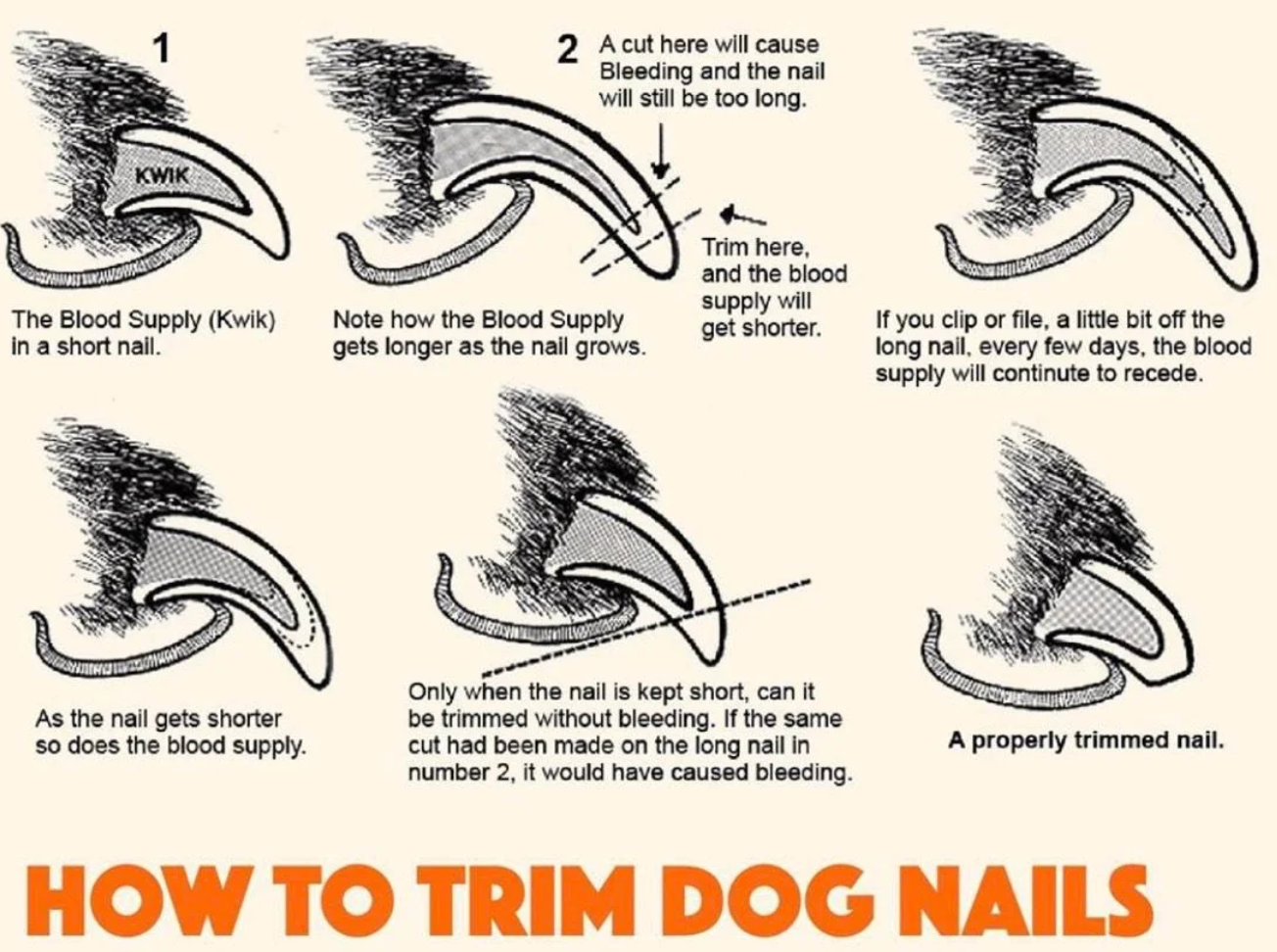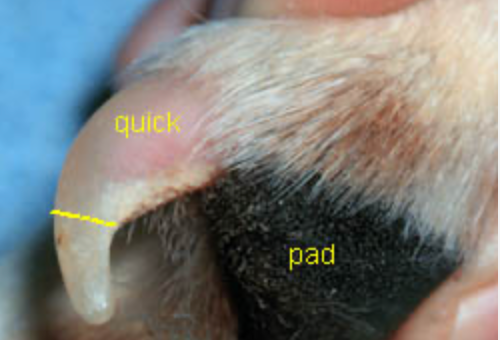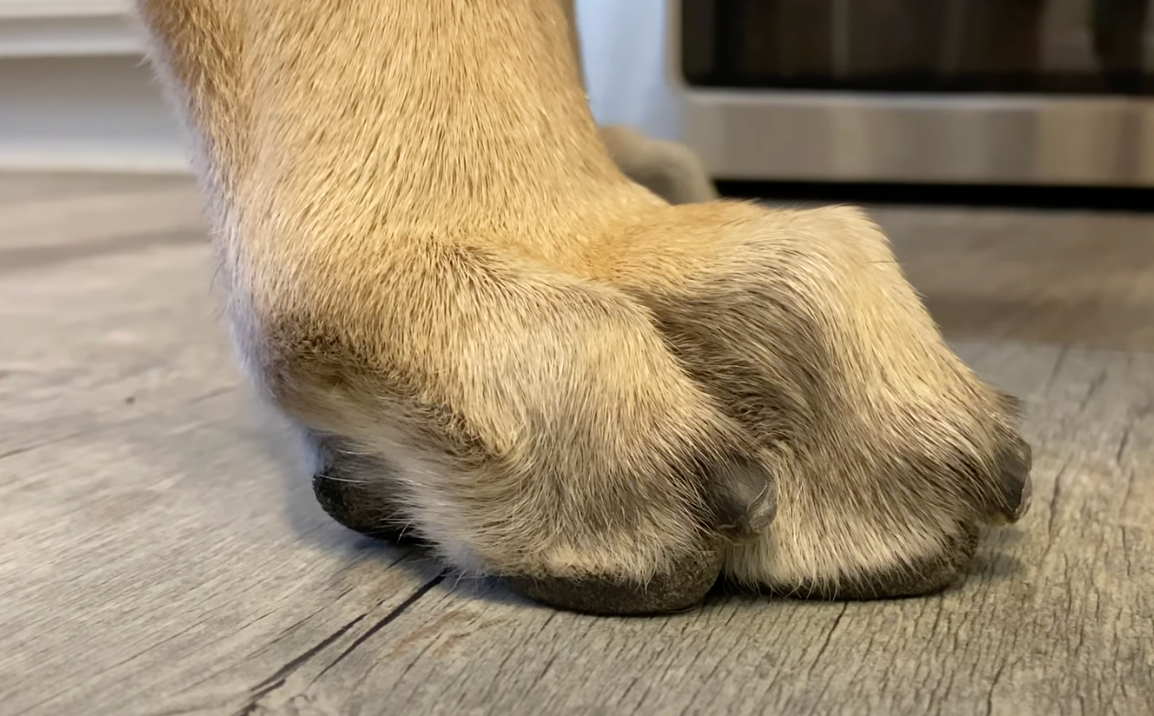
Why TRIM NAILS?
What’s the big deal with dog nails, anyway? As busy pet owners, hearing nails “click click click” along the tile floor is sometimes the only reminder we have that our best friend needs a pedicure. And we oblige, because we know we’re supposed to have their nails trimmed. A pampered clean dog just looks better with short nails, But why do we bother?
The anatomy of a dog’s foot is extraordinary. As humans, we are “plantigrade,” which means when we walk, our toes and metatarsals, the five long bones in the center of the foot, are flat on the ground. But all dogs are “digitigrade,” which means their toes carry most of their weight. A dog’s metatarsals are not flat on the ground; instead, they bear weight differently.
These problems are especially important to remedy in older dogs that may already be struggling with arthritis and aching joints Sometimes the joint isssue is because of long nails!!
So what can be done about this? And how often should you be clipping your dog’s nails anyway? WEEKLY to MAINTAIN .... EVERY OTHER DAY TO SHORTEN
First, determine whether your dog’s nails might be too long. My experince is most dogs nails are too long... If you hear them clicking around as they walk on a hard surface, that’s a decent indicator that it may be time for a trim.
If your dog doesn’t like having his nails trimmed go to bottom of page for tips on training
I personally prefer using a Dremel they make one for pets. Use the sanding band attachment that comes with the Dremel to grind away the nail until the dog starts to pull quickly away... Most dogs are calmer for dremeling than they are for nail trimming with clippers because clippers tend to squeeze the dog’s nail, whereas Dremels take off very small amounts of nail at a time until you get to a point where it is safe to stop. Dremeling also makes it much easier to see the quick: the cuticle full of blood and nerves at the center of the nail. Dremeling the nail, dogs almost always pull the foot away from you when you get too close so even the black nails are easy to do when you listen to the dogs ques. The dust from dremeled nail also helps to clot if you get too close.
Regardless of what tool you use, it’s a good idea to have some quikstop styptic powder on hand to stop bleeding in case you cut too far. As for how often: your dog’s toenail mileage may vary, but I try to trim my own dog’s nails at least once every two weeks. This keeps them short and makes the pedicure sessions shorter and less traumatic. My dogs are all so used to having their nails cut now that they just relax on the floor while I work on their feet!

Nail Trimming

Trim to the yellow line area

Correct Nails
When Viewed from the front the nails are off the ground
When Moving nails do not hit the ground and make any noise

Short nails not only give a neater appearance to the paw, but also allow the dog to stand, walk, and run normally. The shorter nails do not interfere with the appropriate feedback on balance and proprioception when the dog is in motion, or when they are performing various maneuvers involving some degree of agility.

Short nails not only give a neater appearance to the paw, but also allow the dog to stand, walk, and run normally. The shorter nails do not interfere with the appropriate feedback on balance and proprioception when the dog is in motion, or when they are performing various maneuvers involving some degree of agility.
The nails are still long enough to use for traction, but not so long that they interfere with the dog’s normal stride. Short nails encourage proper posture, which in turn places less stress or strain on the dog’s muscles, tendons, ligaments, and joints.
Big deal about long nails

Problems with long nails
Long nails have a greater risk of catching and tearing, which is a big concern with very active dogs. Not only can torn nails bleed a lot, but they can also be exceptionally painful and take a long time to heal. Long nails change the positioning of the dog’s foot and the overall weight distribution across the paw.
Overgrown nails result in a higher rate of injury, both in the foot and wrist, arthritis, and torn or broken toenails.
It also leads to the joints above the nail becoming more sore or causing joint isssues due to compensation.
Problems with long nails
Long Nail Issues
Long nails alter the proprioception and balance of the dog, by altering the overall posture of the dog.
Dogs with long nails are more apt to slip on slick surfaces. Long nails create pain and sensitivity in the dog’s toes, as the jamming of the nails on the ground irritates the sensitive nail bed. It literally can hurt the dog to walk or run with these long nails. This also makes many dogs leery of having their paws touched or nails trimmed, because the nail beds are already so sensitive and painful.
Long nails have a greater risk of catching and tearing, which is a big concern with very active dogs. Not only can torn nails bleed a lot, but they can also be exceptionally painful and take a long time to heal. Long nails change the positioning of the dog’s foot and the overall weight distribution across the paw.
Overgrown nails result in a higher rate of injury, both in the foot and wrist, arthritis, and torn or broken toenails.
It also leads to the joints above the nail becoming more sore or causing joint isssues due to compensation.

When it comes to nail care, many owners would rather hear nails scrabbling on the floor than wrestle with their dogs in an attempt to trim their nails. Many people accept long nails as ‘normal’ or simply tolerate them because their dog “hates having its nails trimmed”, but having a short nail is exceptionally important.
The Downside of Long Nails
How long is “too long?” To put it simply, if you can hear your dog’s nails click on the floor when he walks by, then his nails are definitely too long! It does not have to even be a continuous click, although this clicking certainly indicates exceptionally long nails. If your dog walks on a hard surface and you hear several ticks or drags of the nails in a short period of time (barring any sort of injury or disorder like Degenerative Myelopathy), then the nails are in need of a trim.
What does it matter if the dog’s nails are long or short? As it turns out, it matters greatly! Long nails are not just annoying for anyone who has to sit and listen to the dog scrabble by on the floor, or who gets jumped on, scratched, or pawed by a dog with daggers for nails. Long nails are also detrimental to the dog’s overall health and well-being. Below are some of the top reasons why long nails are risky:
- Long nails have a greater risk of catching and tearing, which is a big concern with very active dogs. Not only can torn nails bleed a lot, but they can also be exceptionally painful and take a long time to heal.
- Long nails change the positioning of the dog’s foot and the overall weight distribution across the paw. Long nails cause the dog to shift its weight to the rear of the foot, causing them to stand and walk more on the back of the pad (see photo to the right). This abnormally stretches the muscles and tendons in the limb, by altering the angle of the toes and placing a strain on the digits, pasterns, and lower limb. Over the long term, this can also cause some degree of splaying of the toes, and can make it painful for the dog to walk properly (often giving owners the illusion that their dog is “arthritic” in its feet, when all it really needs is several nail trims to get the nails short!).
- Long nails alter the proprioception and balance of the dog, by altering the overall posture of the dog. Dogs primarily rely on their paw pads to provide the appropriate feedback in foot positioning during activity, not their nails. When the nails are chronically long, this interferes with the feedback the dog receives about foot positioning. This can cause them to change their movement to accommodate the longer nail, which in turn places excessive stress on the muscles and tendons of the limb. This can also change the way the dog stands, walks, runs, and balances its weight overall, and can lead to chronically tight muscles in both the front and rear of the dogs. In active sport dogs, long nails could potentially lead to increased risk of injury due to this altered posture and excessive tightness in their muscles.
- Long Nails can cause Joint Issues. Because the nail is where the stride begins, if its too long this causes the dog to change how its moving and compensate for pain caused by the nail being jammed into the pad. Think of having a rock in your shoe and trying to walk and run with a rock under your toes. You compensate for the pain the stone is causing. prolonged compensationg can lead to the rest of the body compensating and undue stress on joints, muscles, tendons, etc. Everything is connected and it starts at the nail.
- Dogs with long nails are more apt to slip on slick surfaces, because of the way they must alter their weight-bearing to accommodate the long nails. This increases the risk of a strain or sprain, and makes the dog more unstable on linoleum, wood, or laminate floors. This is especially a concern with elderly dogs, who often grow more “tottery” as they age and are more prone to slipping and falling.
- Long nails create pain and sensitivity in the dog’s toes, as the jamming of the nails on the ground irritates the sensitive nail bed. It literally can hurt the dog to walk or run with these long nails. This also makes many dogs leery of having their paws touched or nails trimmed, because the nail beds are already so sensitive and painful.
The Benefits of a Short Nail
Short nails not only give a neater appearance to the paw, but also allow the dog to stand, walk, and run normally. The shorter nails do not interfere with the appropriate feedback on balance and proprioception when the dog is in motion, or when they are performing various maneuvers involving some degree of agility. The nails are still long enough to use for traction, but not so long that they interfere with the dog’s normal stride. Short nails encourage proper posture, which in turn places less stress or strain on the dog’s muscles, tendons, ligaments, and joints. This is especially important for active dogs, who are constantly in motion or are performing exercises and activities that require them change position in an instant and at speed. Shorter nails also have a lower risk of catching, breaking, splintering, or tearing.
The Canine Nail
Now before you grab your clippers to trim back your dog’s nails, let’s talk about the anatomy of the canine nail. What we actually call the “nail” is just the hard keratin outer shell that serves as an extension of the epidermis. Underneath this hard shell is the softer dermis, the portion of the nail that is soft, fleshy, and infused with nerve endings and a blood vessel known as “the quick”. Under the dermis, at the very heart of the nail, is the bony tip of the dog’s distal phalanx, or toe. This bony tip is called the ungual process, and provides the base structure for the nail.
The portion that is clipped during a nail trim is the excess shell of the nail that has grown beyond the dermis. Normally this should not be painful, just like how clipping your own nails should not be painful. But if the nail is trimmed too close to the living tissue underneath, then the dog will feel pain. If the blood vessel within the nail is clipped, then the dog will not only experience pain but will also now bleed from their nail trim. When this happens, we often say the dog has been “quicked”, because the quick has been cut accidentally. Dogs that have been “quicked” during a nail trim grow much less fond of having their nails trimmed, because now the trim is associated with significant pain.
When nails grow longer, the quick is also growing longer. The quick responds to a trim by slowly receding, and if another trim is made before the nail grows much longer, the quick will recede even more. It is in this manner that a nail may be shortened over time to an appropriate length. We cannot just take a long nail and chop it back to the right size, not without causing immense pain to the dog. It must be done gradually, over the course of multiple nail trims done every few days.
Training the Nail Trim
A few things that have worked for me.
1. Start when pup is young if possibile... if not start slow
2. Regular routine (Trim nails every 1- 2 days to shorten and once a week to maintain). Consistency.
3. Use dremmel Pet on low speed with low grit sand paper.
4. If pup gets restless just do one paw at a time. Coming back later to do another.
5. Treats.
Video below is from our Channel... More Videos will continue to be added so subscribe to our channel so you don't miss any updated or new videos!


